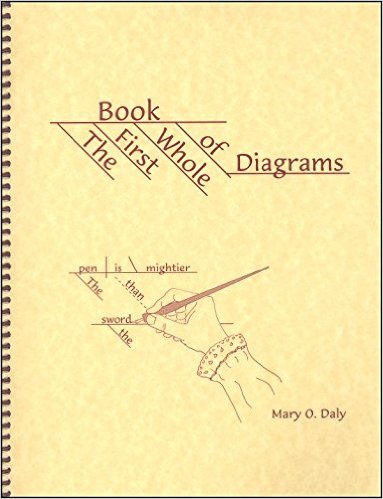Mary Daly has written two books for teaching diagramming. You might purchase either one or both depending upon your situation.
The First Whole Book of Diagrams is a very comprehensive, 194-page, diagramming resource that serves primarily as a teacher resource book. The parent or teacher provides instruction and works through diagramming activities, using both direct instruction and Socratic questioning to help children learn relationships between words in sentences. (It does not use memorized chants for the questions as in Shurley English.)
The book has hundreds of examples of everything from simple subject/verb diagrams through a diagram of one of Shakespeare's sonnets. Instructional material placed in the middle of the book is used by parents as they present lessons for all the sample diagrams up to that point; a few pages of instructions might cover many pages of diagrams examples. Blank diagramming templates scattered throughout the book might be copied and used by students.
Two final chapters combine instruction with challenging diagramming practice as students work through the "Preamble to the Constitution," a portion of the "Gettysburg Address," a Bible verse, a lengthy philosophical quote, some poems (poetry can be tricky!), and a Shakespearean sonnet.
You might begin this book with young children as they learn about subjects and verbs, then use it progressively as your children learn other parts of speech and forms of sentence construction through the most complex clauses.
This is not a complete grammar course, but a supplement for learning diagramming. You will need to use another resource for more comprehensive coverage, including instruction about the various parts of speech.
Elementary Diagramming Worktext is narrower in scope, beginning with subject/verb sentences, then progressing through articles, adjectives, direct objects, linking verbs, adverbs, and prepositions. The last chapter introduces clauses.
Instruction on parts of speech and syntax is more thorough than in The First Whole Book. It features many examples as well as space for student practice. The last forty pages are your answer key.
Elementary Diagramming Worktext is likely to be easier for the parent with little familiarity with diagramming to use. Also, middle school students might be able to work through some of the lessons on their own.
While you might be able to begin using it with children as young as first grade, the general level of language used, including the examples, becomes increasingly challenging. I suspect that third grade would be a more likely level at which to start working through this book. As with The First Whole Book, you might take a few years to work through all the lessons.
Although Ye Hedge School is a Catholic publisher, the content of these books should appeal to all Christians since there is nothing specifically Catholic.
Both books include permission to reproduce pages for a family. Christian schools or class groups can purchase classroom reproduction rights for the Elementary Diagramming Worktext. (The Riggs Institute publishes a different edition of The First Whole Book of Diagrams for schools that is entirely secular called The Complete Book of Diagrams. )











